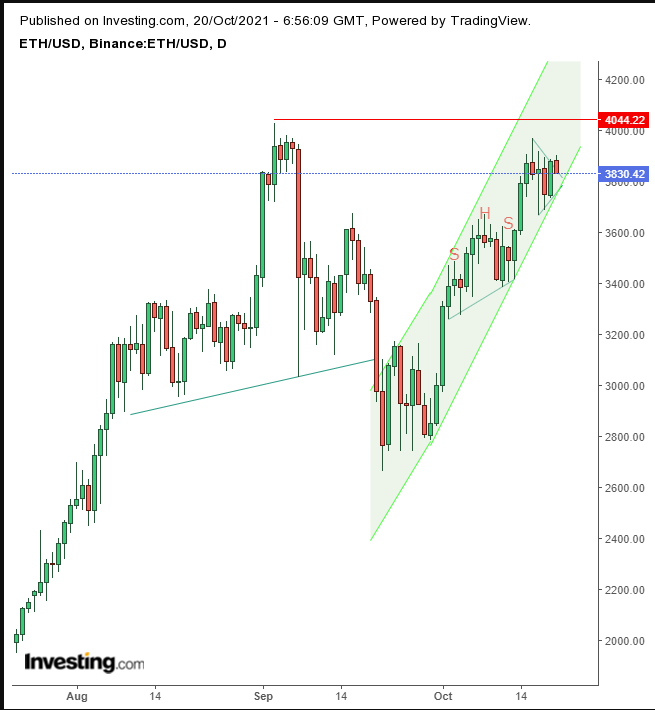On Tuesday, when it debuted on the NYSE, the first Bitcoin futures fund, the ProShares Bitcoin Strategy ETF (NYSE:BITO) rose more than 4%. BTC itself gained 3.5%.
The leading cryptocurrency is getting a boost from two narratives—it's considered an inflation hedge and it's gaining traction from the excitement surrounding the first-ever digital token futures ETF, which is seen to provide legitimacy to what more traditional investors have been considering a faddish asset class.
However, the odds are rising that crypto traders might cash out of Bitcoin after a good run, now that the exchange traded fund has launched.
In the meantime, while Bitcoin has been garnering all the attention, Ethereum, the second-largest digital currency by market cap, has been overlooked. Which means that right now Ethereum could be undervalued, a potentially bullish development for ETH/USD.
Indeed, in our opinion, the supply and demand balance on the daily and weekly charts support that view.
Ethereum is struggling to complete a pennant, presumed bullish after the token's three day straight advance. While price equilibrium suggests that buyers and sellers are in agreement, it may hide a different truth when a pennant develops following a sharp climb.
Bulls who were smart enough (or lucky enough) to have been in for the three-day ride, or even stayed for a fourth day with a higher intraday price, have gotten away with up to +16%. That's an exceptional ramp-up for such a brief period of time.
It stands to reason, then, that they'd want to lock in their profits and cash out—meaning they're going to sell ETH.
That transaction does two things: it reduces demand and increases supply. The fact that a pennant developed suggests that for every bull who wanted out, there was a new bull who wanted in, thus buying the earlier bull's contracts.
When the price breaks, the pennant's topside will indicate that all the available supply has run out and that bulls will be required to bid the digital currency higher for any more supply.
Note, the three-day rally preceding the pennant followed a failed H&S top. That blowout forced traders to reverse positions, providing the oomph for such a significant move.
Moreover, the entire rally since the Sept. 21 low has been confined in the rising channel, which is the product of a much larger H&S that failed from Aug. 7 to Sept. 20. The pennant's development is occurring below the Sept. 3 peak.
For the trend to continue higher all those who want out need to have exited, allowing only traders willing to remain committed to breach the $4,000 psychological barrier.
Here's our takeaway from the weekly chart:

Via the longer term view, it becomes clear that Ethereum has also been trading in a larger-scale range since its early-May record. While the symmetrical nature of the chart suggests equal determination by both buyers and sellers, there are greater odds for the underlying uptrend to continue.
The broader picture clarifies that the pennant's development is not necessarily only the result of the Sept. 3 high, but is also occuring because it's smacking up against the top of a giant symmetrical triangle.
The pennant is the market's way of taking a few steps back so that it can work up another run and gain momentum to help break the triangle top.
Trading Strategies
Conservative traders should wait for an upside breakout that will overtake the September high, then retrace its steps to test what should become the new floor, before risking a long position.
Moderate traders would also wait for the same upside breakout and pullback, but not necessarily to retest support for a better entry.
Aggressive traders could enter a position before the breakout, provided they accept the higher risk, proportionate to the higher reward of beating the rest of the market. Therefore, money management is the key to success. Here's an example:
Trade Sample
- Entry: $3825
- Stop-Loss: $3800
- Risk: $25
- Target: $4000
- Reward: $175
- Risk:Reward Ratio: 1:7
